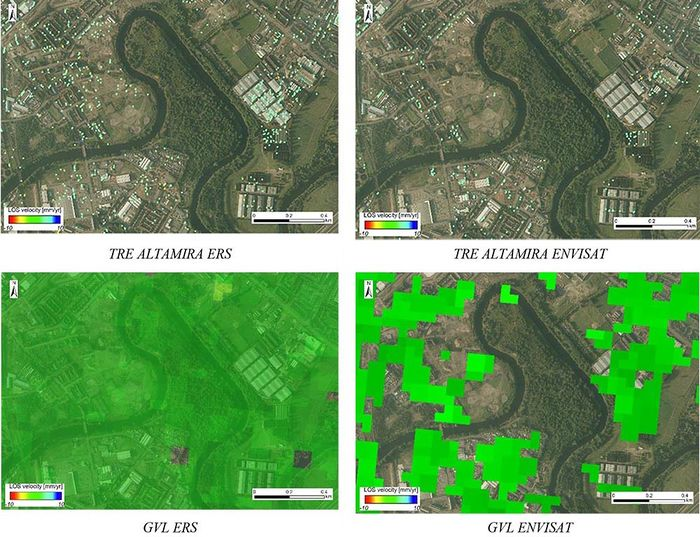OR/18/054 Results
| Bateson, L, and Novellino, A. 2018. Glasgow Geothermal Energy Research Field Site - Ground motion survey report. British Geological Survey Internal Report, OR/18/054. |
Within this section we report the general characteristics for each InSAR dataset as derived from the two different processing techniques. We then present the overall patterns of ground motion within Glasgow for the three time periods covered by the datasets. Following this we examine any ground motions in the GGERFS site and then go on to examine specific ground motions within the wider Glasgow area.
A velocity threshold has been set to ±3 mm/yr considering the standard deviation (σ) of the radar targets in each dataset and the creation of a common arrangement to compare different datasets processed with different techniques (Table 2).
| dataset | geometry | technique | Number of targets | Average σ [mm/yr] |
| ERS | descending | ISBAS | 155 614 | 1.1 |
| Envisat | descending | ISBAS | 28 323 | 1.2 |
| Sentinel-1 | descending | ISBAS | 201 689 | 1.7 |
| ERS | descending | SqueeSAR™ | 191 701 | 0.3 |
| Envisat | descending | SqueeSAR™ | 114 989 | 0.38 |
| Sentinel-1 | ascending | SqueeSAR™ | 247 656 | 0.69 |
| Sentinel-1 | descending | SqueeSAR™ | 256 914 | 0.67 |
Finally, the geolocation precision and relative accuracies associated to the radar target location (in a projected coordinate system) are in the order of a few meters.
ERS
The SqueeSAR™ and ISBAS results from ERS-1/2 data indicates that the majority of the area, including the GGERFS site, was stable in the 1990’s (Figure 2).
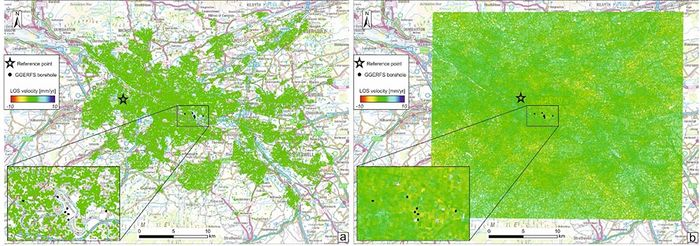
Although Glasgow appears stable overall within the ERS time period (1995–2001) there are small areas, limited to spatially isolated radar targets, exhibiting relatively small rates of subsidence which can be either explained by anthropogenic activities or noise in InSAR results.
ENVISAT
The SqueeSAR™ and ISBAS results from ENVISAT data indicates that the GGERFS site and the majority of the wider area was stable between 2002 and 2010.
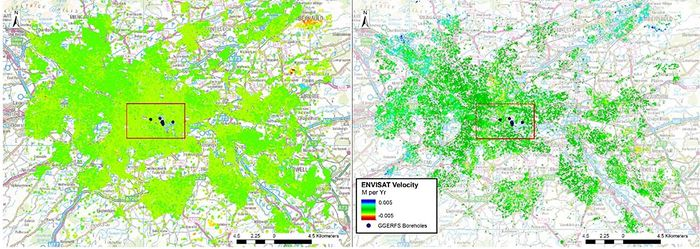
Sentinel-1
TRE ALTAMIRA (Figures 4a–b) and GVL (Figure 4c) results reveal that Glasgow is, overall, relatively stable over the 2015–2017 time period, as processed with Sentinel 1 data. There are notable areas of ground motion, which are addressed in the following sections of this report.
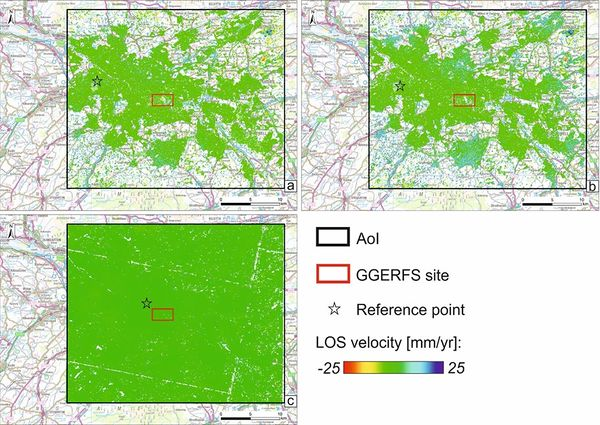
Thanks to the availability of both ascending and descending S-1 SqueeSAR™ results over the AOI (see Figures 4a–b), it was possible to combine the single geometry results in order to obtain 2D measurements, along the vertical (Figure 5a) and the horizontal east–west (Figure 5b) directions, given the assumption of negligible motion in the north-south direction.
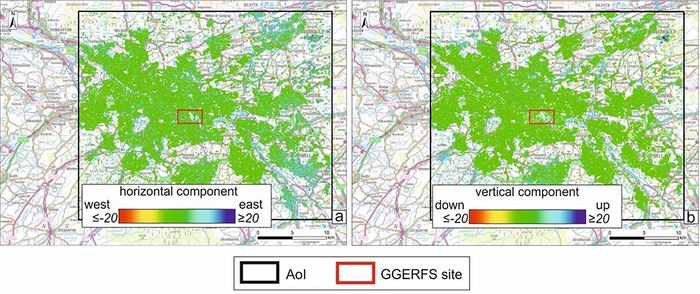
Motion characteristics of the GGERFS site

The GGERFS site itself is being developed south of a woodland park at Cuningar Loop. The Cuningar Loop and surrounding area were redeveloped for the 2014 Commonwealth Games. In the past the, ~35 hectare area within the loop has been used as a waterworks, and for disposal of building demolition rubble and coal mine waste. The creation of the woodland park, within the Cuningar Loop, including paths and play structures has introduced some objects which act as suitable radar targets and therefore become Persistent Scatterers. Therefore in the TRE ALTAMIRA SqueeSAR™ S-1 results (post 2015) (Figure 6) there are a few measurement points whereas in the ERS and Envisat results (pre-development) there are no InSAR points within the Cuningar Loop (Figure 12).
The TRE ALTAMIRA SqueeSAR™ results provide full time series for persistent scatterers, ascending and descending datasets provide more measurement points than the vertical measurements (which are derived through the integration of ascending and descending observations) and hence give an opportunity to see the detailed 2015–2017 ground motions in this area. Examination of the time series for the S-1 ascending data indicate that the area is subsiding by approximately 30 mm over the 2.5 years processed. Time series for the points highlighted in Figure 6 are shown in Figure 7. These indicate that the motion is largely linear in nature.

InSAR time series for the former Athletes Village (the area to the west of the Cuningar Loop) indicate that, although not immediately obvious in the average velocity, this area is also subsiding, although at a lower rate of approximately 15 mm over the 2.5 years processed (Figure 8). This area was developed for the Commonwealth Games Athletes village, development has seen a substantial change in land use. Prior to 2009 two high-rise tower blocks of flats stood in open areas of land (see older aerial photography in Figure 12). These were demolished and smaller accommodation buildings built between 2012 and 2014. We therefore interpret the small rates of linear subsidence seen here relate to settling of the development and loading of the superficial deposits during the widespread development of small buildings.

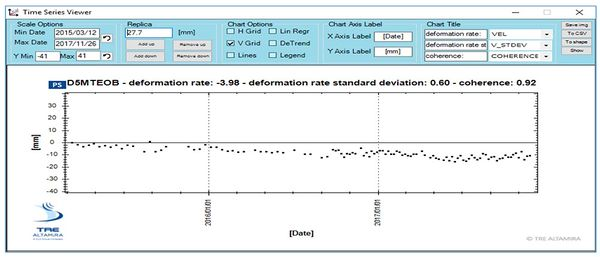
Given the past land use, mapped artificial ground and indications of 35–40 m of superficial deposits on and around the site (Figure 10) it is likely that the subsidence observed here is a result of the development activity and subsequent settling of the infilled ground and/or the superficial deposits. The analysis of the vertical time series from SqueeSAR™ confirms that most of the targets in this area have a discontinuous movement with a slight deceleration of the rate located sometime between October 2015 and November 2017.

The GVL Sentinel 1 data for the GGERFS site indicates that it is mostly stable; there are two small areas with approximately 2–3 mm per year of subsidence within the Cuningar Loop (Figure 11). Although the lack of time series associated with these data makes it difficult to fully understand the indicated motion, they are in the same location as subsiding points in the SqueeSAR™ results and relate to settlement of the built environment.
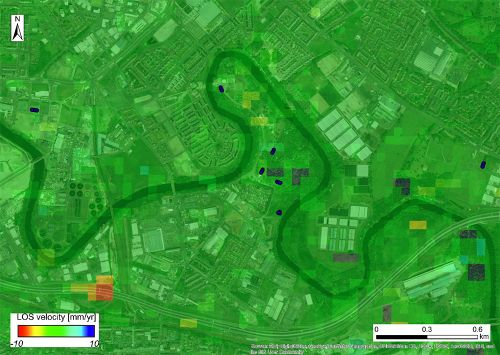
Note the area of subsidence in the lower left corner of Figure 11, motion rates of up to 10 mm per year are observed in both GVL and TRE ALTAMIRA Sentinel 1 results for this area of the M74 motorway. The radar scatterers appear to be related to the motorway gantry but the motion is likely to relate to instability in the embankment supporting the motorway at this location.
ERS and ENVISAT data for the GGERFS site
Although there are no measurement points within the Cuningar Loop, the ERS and ENVISAT InSAR results provided by both TRE ALTAMIRA and GVL indicate the GGERFS and surrounding area to be stable during the 1990’s and 2000’s.
